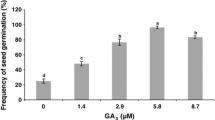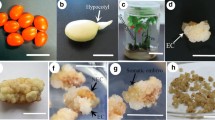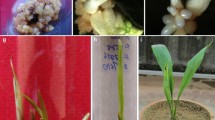Abstract
Callus cultures were established from the scutellum, scutellar node and radicle region of immature embryos of rye and octoploid triticale on modified Murashige-Skoog basal medium supplemented with various growth regulators. 2, 4-D, 2, 4, 5-T and 2, 4, 5-Cl, POP were found suitable for initiation and maintenance of callus cultures. Cytokinins had no or inhibitory effect on callus induction and growth. On basal medium containing 5 mg/l of 2,4,5-Cl3 POP, 16% of triticale and 17% of rye primary cultures exhibited shoot bud regeneration after 3–4 weeks. Transfer of such cultures to basal medium supplemented with zeatin or zeatin in combination with IAA further promoted shoot elongation and plantlet formation. Plantlets were rooted on basal medium containing 1 mg/l NAA and were eventually transferred to soil. Chlorophyll variants were observed in about 6% of triticale cultures.
Similar content being viewed by others
References
Bayliss MW, Dunn SDM (1980) Factors affecting callus formation from embryos of Barley. Plant Sci Lett 14:311–316
Dudits D, Nemet G, Haydu J (1975) Study of callus growth and organ formation in wheat (Triticum aestivum) tissue cultures. Can J Bot 53:957–963
Gamborg OL, Shyluk JP, Brar DS, Constabel F (1977) Morphogenesis and plant regeneration from callus of immature embryos of Sorghum. Plant Sci Lett 10:67–74
Gosch-Wackerle G, Avivi L, Galun E (1979) Induction, culture and differentiation from immature rachises, seeds and embryos of Triticum. Z Pflanzenphysiol 91: 267–278
Green CE, Phillips RL (1975) Plant regeneration from tissue culture of maize. Crop Sci 15:417–421
Harms CT, Lorz H, Potrykus I (1976) Regeneration of plantlets from callus cultures ofZea mays. Z Pflanzenzücht 77:347–351
King PJ, Potrykus I, Thomas E (1978) In vitro genetics of cereals: problems and perspectives. Physiol Veg 16:381–399
Lin M, Staba J (1961) Peppermint and spearmint tissue cultures. Callus formation and submerged culture. Lloydia 24:139–145
Lo PF, Chen CH, Ross JG (1980) Vegetative propagation of temperate forage grasses through callus culture. Crop Sci 20:363–367
Murashige T, Skoog F (1962) A revised medium for rapid growth and bioassay with tabacco tissue cultures. Physiol Plant 15:473–497
O'Hara JF, Street HE (1978) Wheat callus culture — the initiation, growth and organogenesis of callus derived from various explant sources. Ann Bot 42:1029–1038
Rangan TS (1974) Morphogenic investigations on tissue cultures ofPanicum miliaceum. Z Pflanzenphysiol 72:456–459
Sharma GC, Bello LL, Sapra VT, Peterson CM (1981) Callus initiation and plant regeneration fromTriticale embryos. Crop Sci 21:113–118
Springer WD, Green CE, Kohn KA (1979) A histological examination of tissue culture initiation from immature embryos of maize. Protoplasma 101:269–281
Author information
Authors and Affiliations
Rights and permissions
About this article
Cite this article
Eapen, S., Rao, P.S. Callus induction and plant regeneration from immature embryos of rye and triticale. Plant Cell Tiss Organ Cult 1, 221–227 (1981). https://doi.org/10.1007/BF02318918
Received:
Revised:
Issue Date:
DOI: https://doi.org/10.1007/BF02318918




